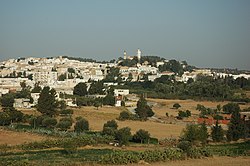Zaghouan
Zaghouan | |
|---|---|
 Zaghouan | |
| Coordinates: 36°24′N 10°09′E / 36.400°N 10.150°E | |
| Country | |
| Governorate | Zaghouan Governorate |
| Population (2014) | |
| • Total | 20,837 |
| Time zone | UTC+1 (CET) |
Zaghwan (or Zaghouan; Arabic: زغوان ) is a town in the northern half of Tunisia.
Situated on a low ridge of the Dorsale Mountains, the town has a mild climate and presents a green aspect. Cold water from here was taken by aqueduct to Carthage. The town is famous for its roses, originally cultivated by Muslim refugees from Spain in the seventeenth century. The town is located around 100 km due south of Tunis and around 50 km inland (west) from the Gulf of Hammamet and has an estimated population of around 20,837 (2014). It is the capital of the Zaghouan Governorate.
On the mountain south of the city is the Roman Water Temple Djebel Zaghouan (Temple de Eaux), source of an aqueduct which used to take water to the city of Carthage over 100 km away.
Ecclesiastical history
Zagwan is the presumed site of the Ancient city of Zica, which was among the many of sufficient importance in the Roman province of Africa Proconsularis to become a suffragan diocese of the Metropolitan of Carthage, in the papal sway, yet was to fade completely, probably at the seventh century advent of Islam.
Its historically documented bishops were :
- Donatist schismatic Donatus attended the Council of Carthage in 411, where his heresy was condemned as such by the Catholic bishops, among whom Zica had no counterpart
- Vincentius intervened at the Council of Carthage in 484 called by king Huneric of the Vandal Kingdom, and was afterwards exiled like most Catholic bishops.
Titular see
The diocese was nominally restored in 1933 as Latin Titular bishopric of Zica (Latin = Curiate Italian) / Zicen(sis) (Latin adjective).
It has had the following incumbents, of the fitting Episcopal (lowest) rank, with an archiepiscopal exception:
- Titular Archbishop: Marius-Félix-Antoine Maziers (1966.01.24 – 1968.02.05) as Coadjutor Archbishop of Bordeaux (France) (1966.01.24 – 1968.02.05); next Metropolitan Archbishop of Bordeaux (France) (1968.02.05 – retired 1989.05.31), died 2008; previously Titular Bishop of Augustopolis in Phrygia (1959.12.17 – 1966.01.24) as Auxiliary Bishop of Archdiocese of Lyon (France) (1959.12.17 – 1966.01.24)
- Christopher Mwoleka (1969.03.06 – 1969.06.26) as Auxiliary Bishop of Diocese of Rulenge (Tanzania) (1969.03.06 – succession 1969.06.26); next Bishop of Rulenge (1969.06.26 – 1996.11.08), died 2002
- Joachim Mbadu Kikhela Kupika (1975.01.30 – 1975.11.22) as Coadjutor Bishop of Boma (Congo-Kinshasa) (1975.01.30 – 1975.11.22); next Bishop of Boma (1975.11.22 – retired 2001.05.21), emeritate as Titular Bishop of Belesasa (2001.05.21 – ...)
- BIOS TO ELABORATE
- Francisco Capiral San Diego (1983.06.06 – 1995.07.12)
- Luigi Locati (1995.12.15 – 2005.07.14)
- Silvio José Báez Ortega, Teresian Carmelites (O.C.D.) (2009.04.09 – ...) as Auxiliary Bishop of Archdiocese of Managua (Nicaragua) (2009.04.09 – ...)
Gallery
-
Postcard of Zaghouan in 1900
-
Zaghouan in Tunisia
-
Tunisie Parc on Djebel Zaghouan
See also
Sources and external links
- Bibliography - Zica bishopric
- J. Mesnage, L'Afrique chrétienne, Paris 1912, pp. 237–238




